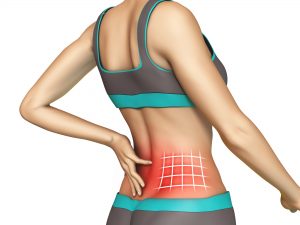The sacroiliac joint is responsible for connecting the sacrum bone at the bottom of the spine to the pelvis. While small, this joint is very strong as it provides stability and absorbs shock to this area. It is triangular in shape and is formed by the fusion of several vertebrae during development. You can even see these joints on the surface of your back as they look like two small dimples on each side of the lower back and above the buttocks.
The sacroiliac joint allows your hips, legs and spine to function properly without pain or added pressure. If you’re experiencing pain in this joint, it can be tricky because it is often caused by too much activity or too little activity. Usually if you feel pain in the lower back, hips and groin, this means that your SI joint is being overworked. Yet if the pain is centralized to your lower back and buttocks and travels down your leg, the SI joint pain could be caused in part by inactivity.
While too much activity and not enough activity can be causes of SI joint pain, pregnancy is also a common cause of this condition. The added pressure and weight can cause the SI joint to align abnormally. This is the reason why many pregnant women experience SI joint pain.
Symptoms of SI Joint Pain

SI Joint pain is often felt in the back or buttocks. Sometimes SI joint pain radiates down one or both legs, all of the way down to the foot. This pain is often confused with a herniated disk or issues with the spine. Unfortunately, this pain tends to make sitting more difficult.
Diagnosis
If you have been experiencing this type of lower back and buttocks pain, SI joint pain is a possibility. You should consult a qualified physician for a thorough examination and accurate diagnosis. SI joint pain is typically associated with inactivity and over-activity, so if you have recently started an intense workout program or have been sitting more than usual lately, your pain could be linked. It is best to seek medical attention with this type of pain to rule out other medical conditions and to get the treatment you need to feel better.
Your physician will complete a historical and physical exam to understand your symptoms. He or she will then check your posture and will likely examine your walking gate. You may also have lab exams or X-rays to determine whether your pain is related to the SI joint.
Treatment
Once your physician has determined that your pain is SI joint pain, he or she will most likely recommend that you take anti-inflammatory medications like ibuprofen. You should also rest your back by limiting your activities. Some patients have seen improvement from wearing a sacroiliac belt. This device wraps around the hips and holds the sacroiliac joint. Physical therapy and cortisone injections have been known to reduce pain as well. Surgery is also an option, but should only be considered in very serious cases.
If you are experiencing SI joint pain, you may want to seek medical attention. Louisville orthopaedic surgeon and board certified sports medicine doctor Stacie Grossfeld M.D. can help diagnose and treat your joint pain. For more information about this type of pain or to schedule an appointment, call the office at 502-212-2663.

Recent Comments